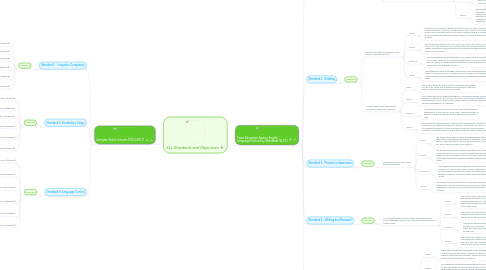
1. Arlington Public Schools (ESOL/HILT)
1.1. Standard 1: Linguistic Complexity
1.1.1. Objectives
1.1.1.1. Level 1 (Entering)
1.1.1.1.1. Pictorial or graphic representation of the language of the content areas
1.1.1.2. Level 2 (Beginning)
1.1.1.2.1. General language related to the content areas
1.1.1.3. Level 3 (Developing)
1.1.1.3.1. General and some specific language of the content areas
1.1.1.4. Level 4 (Expanding)
1.1.1.4.1. Specific and some technical language of the content areas
1.1.1.5. Level 5 (Bridging)
1.1.1.5.1. Specialized or technical language of the content areas
1.1.1.6. Level 6 (Reaching)
1.1.1.6.1. Specialized or technical language reflective of the content areas at grade level
1.2. Standard 2: Vocabulary Usage
1.2.1. Objectives
1.2.1.1. Level 1 (Entering)
1.2.1.1.1. Words, phrases or chunks of language when presented with one-step commands, directions, choice or yes/no questions, or statements with sensory, graphic or interactive support
1.2.1.2. Level 2 (Beginning)
1.2.1.2.1. Phrases or short sentences
1.2.1.3. Level 3 (Developing)
1.2.1.3.1. Expanded sentence in oral interaction or written paragraphs
1.2.1.4. Level 4 (Expanding)
1.2.1.4.1. A variety of sentence lengths of varying linguistic complexity in oral discourse or multiple, related sentences or paragraphs
1.2.1.5. Level 5 (Bridging)
1.2.1.5.1. A variety of sentence lengths of varying linguistic complexity in extended oral or written discourse including stories, essays or reports
1.2.1.6. Level 6 (Reaching)
1.2.1.6.1. A variety of sentence lengths of varying linguistic complexity in extended oral or written discourse as required by the specified grade level
1.3. Standard 3: Language Control
1.3.1. Objectives
1.3.1.1. Level 1 (Entering)
1.3.1.1.1. Words, phrases or chunks of language when presented with one-step commands, directions, choice or yes/no questions, or statements with sensory, graphic or interactive support
1.3.1.2. Level 2 (Beginning)
1.3.1.2.1. Oral or written language with phonological, syntactic or semantic errors that often impede the meaning of the communication when presented with one to multiple-step commands, directions, questions or a series of statements with sensory, graphic or interactive support
1.3.1.3. Level 3 (Developing)
1.3.1.3.1. Oral or written language with phonological, syntactic or semantic errors that may impede the communication , but retain much of its meaning, when presented with oral or written narrative or expository descriptions with sensory, graphic or interactive support
1.3.1.4. Level 4 (Expanding)
1.3.1.4.1. Oral or written language with minimal phonological, syntactic or semantic errors that do not impeded the overall meaning of the communication when presented with oral or written connected discourse with sensory, graphic or interactive support
1.3.1.5. Level 5 (Bridging)
1.3.1.5.1. Oral or written language approaching comparability to that of proficient English peers when presented with grade level material
1.3.1.6. Level 6 (Reaching)
1.3.1.6.1. Oral or written communication in English comparable to proficient English peers
2. Texas Education Agency English Language Proficiency Standards (ELPS)
2.1. Standard 1: Listening and Speaking
2.1.1. Objectives
2.1.1.1. The student will develop oral communication skills.
2.1.1.1.1. Level 1
2.1.1.1.2. Level 2
2.1.1.1.3. Level 3-4
2.1.1.1.4. Level 5
2.1.1.2. The student should be able to demonstrate listening skills by using context clues to gain meaning from appropriate English leveled text read orally and by following oral directions and compare with visual or nonverbal models
2.1.1.2.1. Level 1
2.1.1.2.2. Level 2
2.1.1.2.3. Level 3-4
2.1.1.2.4. Level 5
2.2. Standard 2: Reading
2.2.1. Objectives
2.2.1.1. Students will apply knowledge of how print is organized and read.
2.2.1.1.1. Level 1
2.2.1.1.2. Level 2
2.2.1.1.3. Level 3-4
2.2.1.1.4. Level 5
2.2.1.2. Student should read, comprehend, and analyze fiction and nonfiction.
2.2.1.2.1. Level 1
2.2.1.2.2. Level 2
2.2.1.2.3. Level 3-4
2.2.1.2.4. Level 5
2.3. Standard 3: Phonemic Awareness
2.3.1. Objectives
2.3.1.1. The student will learn and apply phonetic principles.
2.3.1.1.1. Level 1
2.3.1.1.2. Level 2
2.3.1.1.3. Level 3-4
2.3.1.1.4. Level 5
2.4. Standard 4: Writing and Research
2.4.1. Objectives
2.4.1.1. The student should be able to write simple explanations, short paragraphs, stories, letters and short reports across all content areas.
2.4.1.1.1. Level 1
2.4.1.1.2. Level 2
2.4.1.1.3. Level 3-4
2.4.1.1.4. Level 5
2.5. Standard 5: Media
2.5.1. Objectives
2.5.1.1. The student should be able to locate and use information in reference materials by using level appropriate pictures and charts.
2.5.1.1.1. Level 1
2.5.1.1.2. Level 2
2.5.1.1.3. Level 3-4
2.5.1.1.4. Level 5
2.5.1.2. The student will use information resources to research a topic and develop a question about a topic.
2.5.1.2.1. Level 1
2.5.1.2.2. Level 2
2.5.1.2.3. Level 3-4
2.5.1.2.4. Level 5
